Bella May Leonard interview: Sculptural embroidery
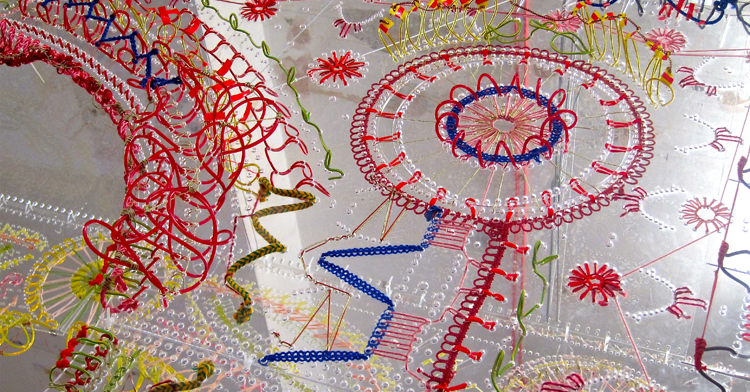
We were introduced the the work of recent graduate Bella May Leonard at the Knitting and Stitching show 2013. She was selected by the Embroiderers’ Guild to have a stand in their Graduate Showcase Gallery; upon visiting the stand, we were immediately struck by Bella’s ‘collages’. The use of unusual source materials, the stylistic flair of the pieces, and the originality of the work within the context of contemporary textiles, all made us want to find out more about the person behind the artwork.
In our interview with Bella, she tells us why she uses the term ‘sculptural embroidery’ to describe her work in an attempt to challenge pre-conceived notions of what embroidery in art actually is.
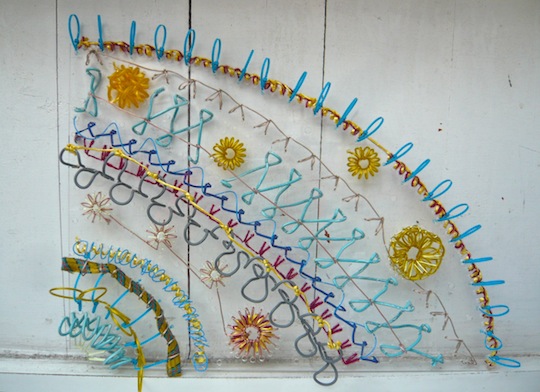
Bella Leonard – Embroidered Sample
An art form realised physically
TextileArtist.org: What initially captured your imagination about textile art?
Bella Leonard: The sculptural aspect of textile art for me is intriguing; three-dimensional, interweaving threads that build up structure with colour and texture is exciting. Textiles are loaded with history and can communicate to a universal audience, making textile art, to me, very accessible. While it demonstrates considerable thought and consideration even if intuitive, it is an art form realised physically; its tactile nature is captivating. Artists questioning and experimenting in this very tangible medium I find playful and provocative.
What or who were your early influences and how has your life/upbringing influenced your work?
My mother is an unbelievably talented maker. I have been surrounded by her creative and tenacious energy, style and textile hoard growing up. This ensured an exposure to textiles and making in everyday life, without being forced to acknowledge it. Both my parents and family friends have influenced me choosing an art based education and given me confidence to have faith in my own creative process. Annoyingly from too young an age, my mother informed me, and continued to tell me, I was a sculptor after I got very excited by colourful electrical cable in a local junkyard. Apparently this enthusiasm for cable has never left, despite more than a decade of attempts trying to prove my mother could not simply label and box my identity so easily. Although reflecting on my current work, it may be that she had a point…
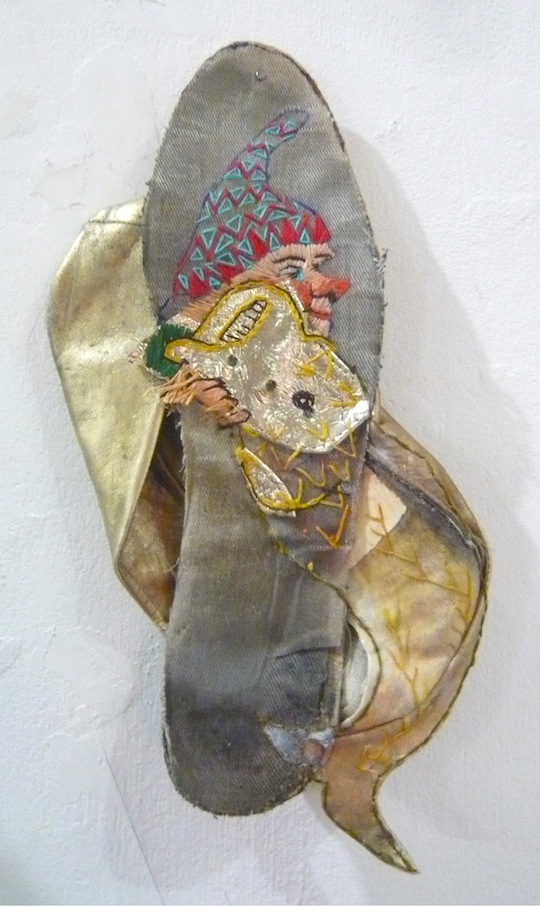
Bella Leonard – Embroidered Shoe
What was your route to becoming an artist?
In school I consistently obtained a good mark in Art, which lead me to an Art Foundation course at Cheltenham after finishing my A levels. This whirlwind year of new experience exposed me to the idea of studying textiles seriously as an art, having been slightly bored of sculpture and frustrated by animation. Advised by my patient tutor, Matthew Harris, I sceptically went to see the Embroidery BA in Manchester. Overwhelmed by the feeling that course had been written just for me, I happily accepted their offer. After two years of enjoying living in a city for the first time and therefore reasonably unsuccessful study, I took a year off from formal education. This ensured that in the final year of the degree I could focus completely on the course. The work I achieved in this year has now spring boarded me to employment as an artist.
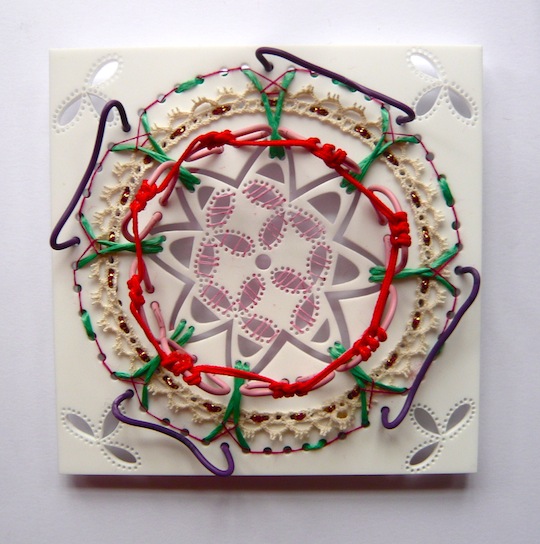
Bella Leonard – Embroidered Tile, 2013
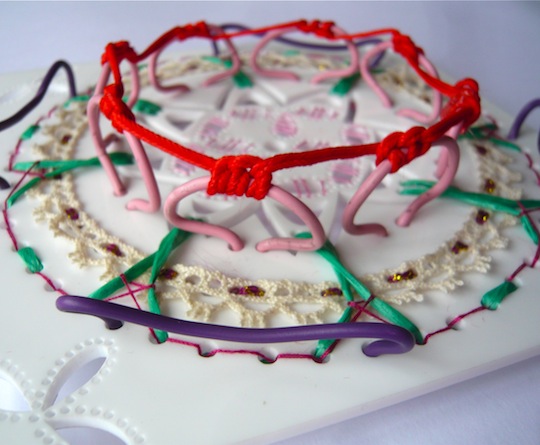
Bella Leonard – Embroidered Tile detail, 2013
Battling with colour
What is your chosen medium and what are your techniques?
I elaborate on hand embroidery techniques, responding to the materials I choose and collect. I enjoy battling with colour and would describe my process as a collaging technique. Making decisions with colour combinations, scale and shape are made intuitively as I work until I feel a piece is resolved and balanced. I really like using materials that have connotations of previous use, so my process feels resourceful and the work is unique in its experimentation.
How would you describe your work and where do you think it fits within the sphere of contemporary art?
I describe my work as sculptural embroidery. In using the term ’embroidery’, I can challenge assumptions and stereotypes of embroidery as a twee craft. I like to have embroidery as a base to then work from, even if other people are unsure of what it means, it helps me define and focus my practice. I do not yet know how my work fits within the sphere of contemporary art. However, I am encouraged and take inspiration from so many large scale textile art installations in galleries, such as The Haunch of Venison or The Whitworth Art Gallery, I would very much like the opportunity to have mine there too!
Tell us a bit about your process and what environment you like to work in?
My process of working is spontaneous and intuitive, so I like to know I have a huge window of time ahead of me so I can relax into whatever it is I would like to achieve. Embroidery is very meditative and can take hours for something quite small. My concentration is kept better if there is radio or music in the background to spur me on. When actually making I like to be alone or at least with head phones for concentration. However, I have recently made an embroidered installation which I started ‘live’ at an opening party in Berlin. I had not anticipated people’s varying reactions but I actually really enjoyed the work inspiring conversation.
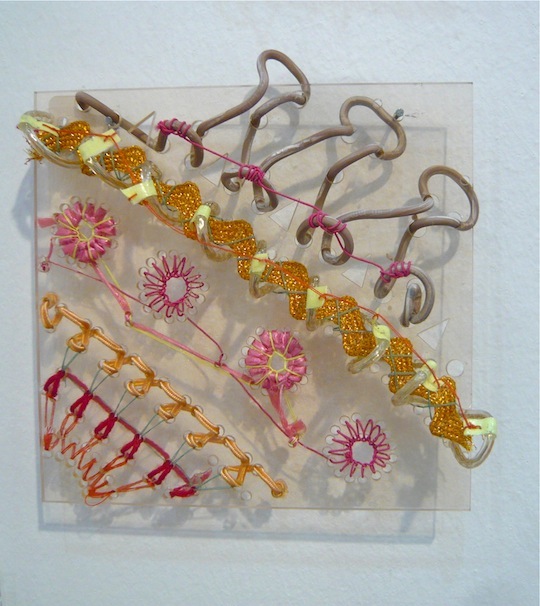
Bella Leonard – Embroidered Tile 2, 2013
An intuitive, naive process
Do you use a sketchbook?
I use a sketchbook to work out patterns, draw from life and plan sculptural ideas. It is a workbook in progress though and I am quite happy to make a piece straight away without it, just the materials alone. However, it is more than likely I will end up sketching and planning during the making, or reference a previous idea or drawing.
What currently inspires you and which other artists do you admire and why?
I am inspired by other artists work such as Shelly Millar. Her work experiments with traditional pattern, juxtaposing it with urban graffiti patterns on brick walls and the unconventional material; icing sugar. I am fascinated by the complexity of pattern, and the deliberation of how decoration or ornamentation can be considered art. Her work is playful in its interpretation and I like that it has a limited life.
I love the work of Henrique Oliveria who uses found wood to make huge colourful sculpture that is actually very textural. During my degree, his work assured me I could use found materials effectively by understanding their qualities, rather than trying to make colour myself through a dyeing process (something I struggled with).
I have great admiration for the artist Violetta Parra, a national Chilean folk heroine. As well as being a musician and painter, she embroidered many large wall hangings and banners with colourful scenes of characters and animals. My admiration comes from her persistent determination to express herself through her art. Completely untrained, as an Outsider artist in 1964 she became the first Southern American woman to have her textile work exhibited at the Louvre, Paris. I am unbelievably encouraged by her self-belief.
How has your work developed since you began and how do you see it evolving in the future?
My practice has been allowed to develop simply because I have dedicated more time to it during my course. Beginning the final year of my degree with a focused attitude meant that ideas I had had previously could finally be resolved, instead of not quite communicating what I wanted and then moving on to another project.
I envisage maintaining a folk aesthetic, keeping my process intuitive and almost naive, but develop a sophisticated finish to ensure installations I achieve read well in public contexts. Continuing to use hand embroidery techniques, I hope these skills will enable me to accomplish more complex pieces of considerable scale. As I continue making, collaboration with other artists, designers and employers, will hopefully broaden the possibilities for my practice into new fields.
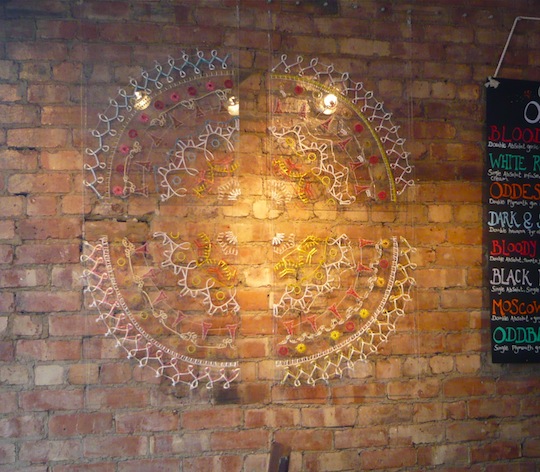
Bella Leonard – Oddest Exhibition, 2013
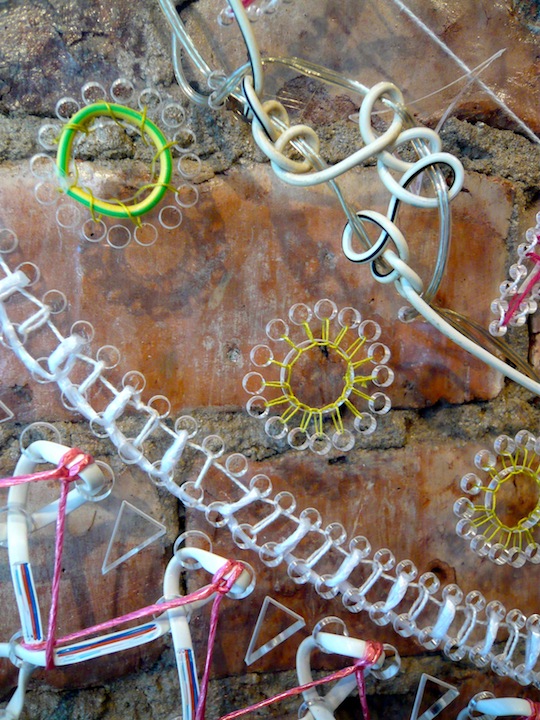
Bella Leonard – Oddest Exhibtion detail, 2013
Taking work into new contexts
What advice would you give to an aspiring textile artist?
My advice would be to take your time to play with your materials to find your own way of getting the best out of them. It is ok to make something you feel is rubbish because something better will follow; give yourself time to re-work it or learn from it. While being aware of what people can conventionally think about textiles, it is important to experiment and find out what it is that you like about the thread or texture or colour.
Most importantly, I advise keeping perspective on your work. This means not only looking at textile artists for direction but also finding inspiration from film, music, events, theatre, architecture… While I am very keen that textile art is considered as ‘valid’ as fine art, it is important to realise how and why it is often viewed separately. Taking work into new contexts ensures you can stay alert to new possibilities and potential.
What are your favourite resources?
I found this book really interesting and inspiring even if it isn’t directly about textiles… “Raw + Material = Art. Found, Scavenged and Upcycled” (Tristan Manco).
I like to see and feel textiles in person in galleries, private collections or museums. Collecting textiles from charity shops, car boot sales, vintage fairs etc. is also a very useful way to understand what already exists and gives me inspiration for new projects.
‘Pintrest‘ is a really good, quick and easy way to organise all the visuals that inspire you from the internet. Although it is important to remember they are usually viewed just thumbnail images.
Blogs I enjoy include:
What piece of equipment or tool could you not live without?
This is too hard because I enjoy making do with what is lying around me. However, for the perspex work, I couldn’t do it without a laser cutter.
Where can readers see your work in the near future?
Most recently, I have been working on a sculpture in Berlin at the Generator Hostel, Mitte. The large ‘G’ logo was embroidered over a week long period and will now be in their courtyard for the foreseeable future.
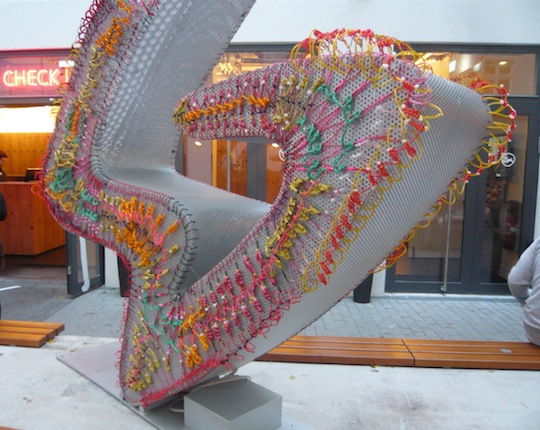
Bella Leonard – ‘G’ sculpture commission, Berlin. October 2013
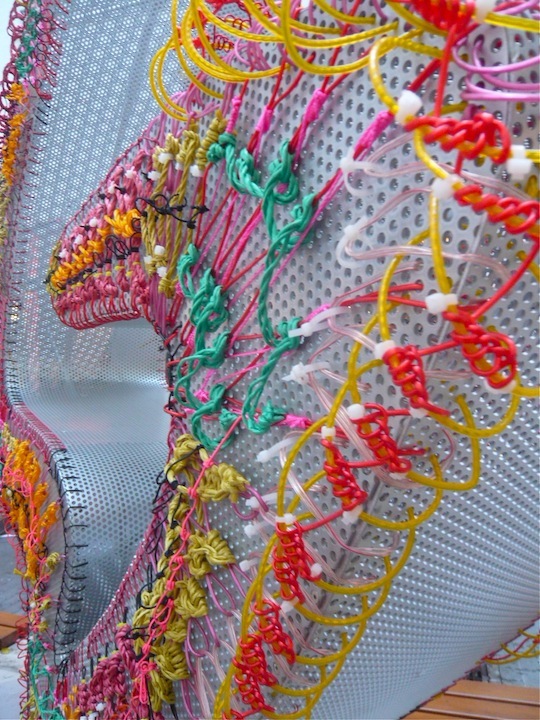
Bella Leonard – ‘G’ sculpture commission, Berlin. Detail. Oct. 2013
To find out more about Bella May Leonard visit BellaMayLeonard.com or Bella’s Tumblr Page
















I love the last piece- “G” sculpture! (I am wondering what that stands for 😉 It’s hit the spot for me….!) The sculptural form is exciting and takes this unusual technique into some very interesting territory. Another gnome/elf….they must be really popular in your neck of the woods! Here, it is owls. I can’t wait to see where Bella may goes with this work…wish I had known about her when I did my piece on plastics fiber artists for Fiber Art Now magazine! I might have to do a follow up!
Great interview! Loved the piece of sculptural embroidery work. Thanks for sharing this with us.
Great work
This is the great work